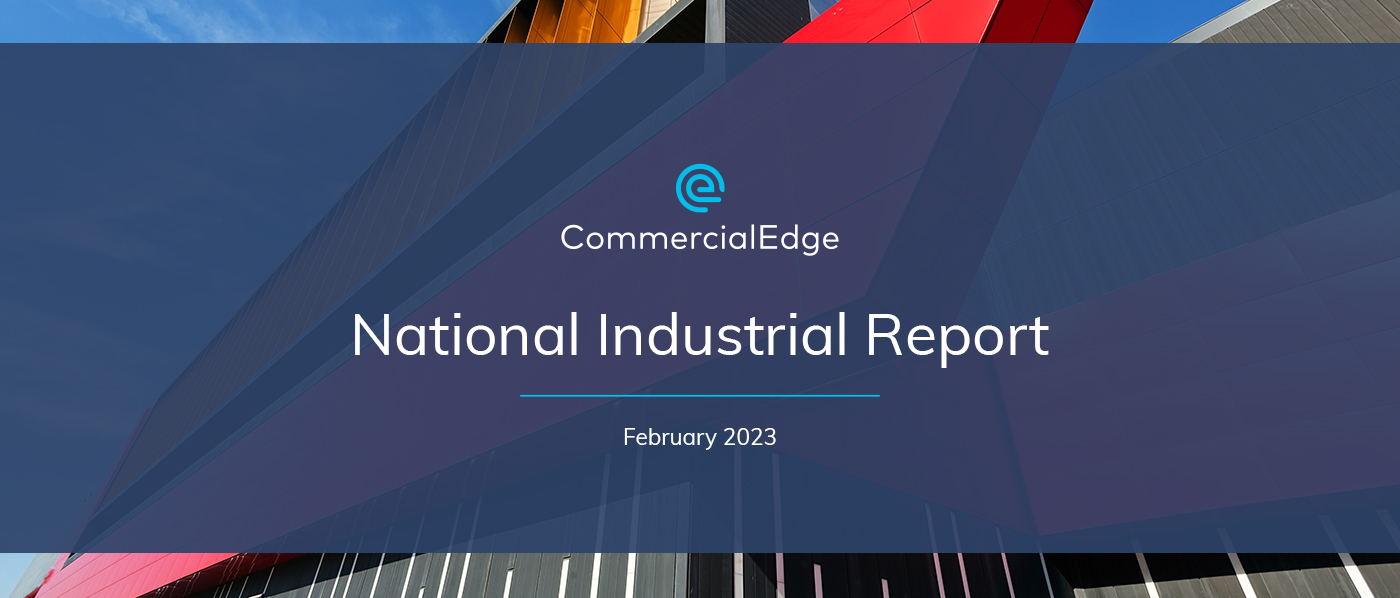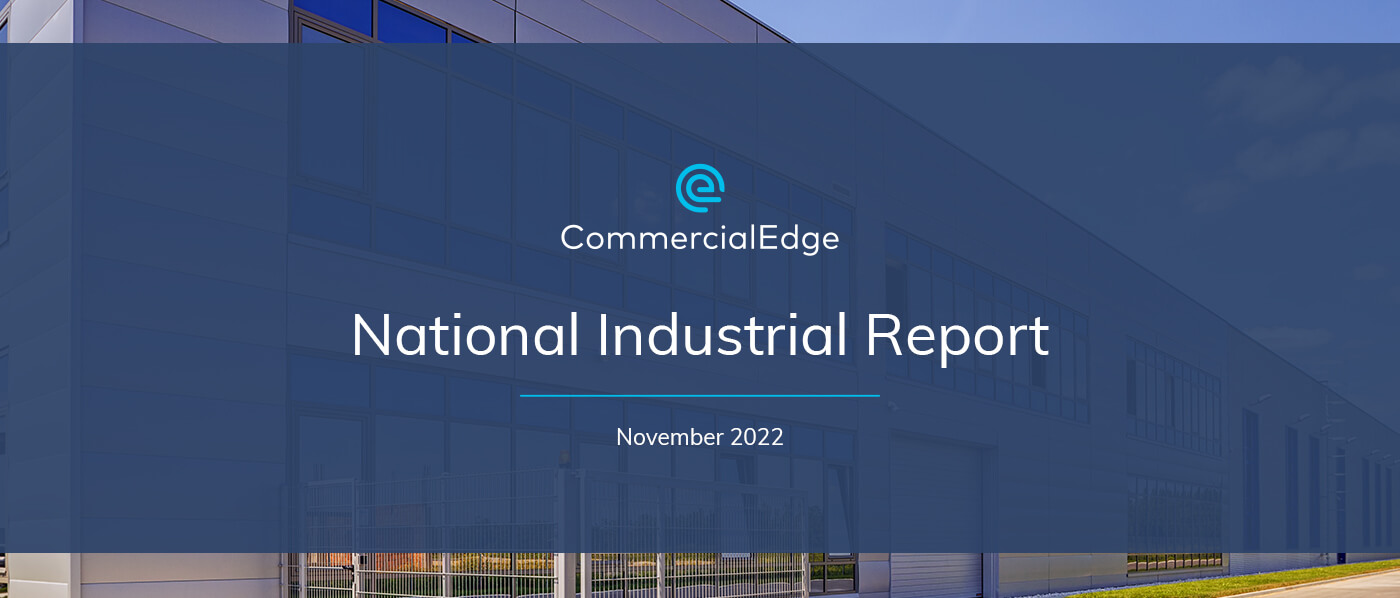Key Takeaways:
- National industrial in-place rents averaged $7.10 per square foot in January, up 6.9% year-over-year
- The national vacancy rate stood at 4.0%, up 10 basis points month-over-month
- Nationwide, 691 million square feet of industrial space was under construction
- Industrial transactions totaled $1.1 billion at an average sale price of $125 per square foot
- Western markets posted the widest lease spreads, with the Inland Empire registering a spread of 28.2%
- Columbus recorded the second lowest vacancy rate nationwide at 1.7%
- Dallas led the nation in development with a 61.6 million-square-foot pipeline
- New Jersey sales volume second highest among leading markets at $149 million
Demand for industrial space has remained elevated since the onset of the pandemic and owners are benefiting from this when leases expire. Yardi Market Insight, a cutting-edge service that uses anonymized and aggregated data from other Yardi platforms found that of the 63 markets it covers, 44 reached a lease spread greater than 10%. Of these, 16 markets had spreads wider than 20% in January.
The widest spreads are generally found in port markets and logistics hubs, although some tertiary and emerging markets have also seen outsized lease spreads as well, the CommercialEdge U.S. industrial market report noted.
“Savvy investors are already seeking out projects with shorter lease expiration schedules and seem to be willing to pay a premium for them. It’s another opportunity to benefit from the historic run-up in rates as vacancy remains tight.”
Peter Kolaczynski, CommercialEdge Senior Manager
With such substantial spreads, properties with leases that expire soon will be more attractive on the transaction market. Given the current interest rate environment and economic uncertainty, leasing expiration schedules could be the difference between a deal penciling out or not.
Rents and Occupancy: New Supply to Put Slight Upward Pressure on Vacancy Rates
National in-place rents for industrial space averaged $7.10 per square foot in January, up 6.9% year-over-year and seven cents over December, according to the CommercialEdge industrial market report. Leases signed in the last 12 months reached a national average of $9.01 per square foot, $1.88 more than in-place contracts.
Some of the widest spreads between new leases and the market average were in Los Angeles ($7.26 more per square foot), the Inland Empire ($6.06), Orange County ($5.43), New Jersey ($3.61), Nashville ($3.35) and Miami ($3.31) — a trend that held steady over the past few quarters with little variation.
Average Rent by Metro
The national vacancy rate was 4.0%, an increase of 10 basis points over the previous month. After months of decreases, this marks the second month in a row that the national vacancy rate has increased. The upticks have been minor but are likely driven by record levels of new supply. It will be worth watching if vacancies continue a slow upward push or plateau off in coming months.
The lowest industrial vacancy rates in the country were found in the Inland Empire (1.6%), Columbus (1.7%) and Charlotte (2.2%). Despite the low vacancy rates, heavy new supply is putting downward pressure on industrial rent rates in some markets, especially in those with more developable land. For instance, in Charlotte, rents increased only by 2.8% year-over-year in January, meanwhile industrial projects underway accounted for 5.3% of existing stock — the third largest pipeline nationwide on a percentage-of-stock basis.
Supply: Logistics Remain a Major Driver of Industrial Development
Nationally, 691 million square feet of new industrial supply was under construction as of January, accounting for 3.8% of existing inventory. An additional 706.6 million square feet were in the planning stages, for a potential stock increase of 7.7%.
Industrial Space Under Construction (Million Sq. Ft)
While industrial construction is happening in markets across the country, much of it is concentrated in a handful of markets. The 10 largest pipelines make up nearly 40% of all stock under construction and the top two markets (Dallas and Phoenix) account for one-sixth of all square footage currently being built.
Most of the new construction is fueled by the logistics sector, especially in Dallas. The largest project in the market is a 2.5 million-square-foot Walmart fulfillment center in Lancaster, Texas. Beyond that property, there are 13 logistics buildings under construction — including both new properties and expansions at existing sites — that are larger than one million square feet.
Transactions: Sales Activity Likely to Slow in 2023 Despite Investor Appetite
There were $1.1 billion in industrial transactions in January, according to the CommercialEdge industrial report. The national average sale price in January of this year came in at $125 per square foot.
Although demand for industrial real estate remains high, transaction volume is likely to fall this year, industrial property outlooks predict. Rising interest rates are slowing investment across all asset classes and the industrial sector is not immune. The higher cost of capital is leading investors to reevaluate their allocations and underwriting assumptions.
2023 Year-to-Date Sales (Millions)
Investors are also worried that inflation could continue to eat away at yields if leases at properties include only minor escalations. A potential recession on the horizon could dampen tenant demand in all but prime markets, although vacancies are tight enough that a mild economic downturn would likely have minimal effect.
The run-up in prices that has occurred over the last few years means that there is a smaller pool of attractive properties that can pencil out for investors. The average sale price of an industrial property in the fourth quarter of 2022 was $134 per square foot, a 76% increase from the first quarter of 2019.
Western Markets: Southern California Logs the Highest Lease Spreads in the Country
The ports of Los Angeles and Long Beach set records for numbers of containers handled in recent years and were a key bottleneck during the worst of the supply chain crisis. This led to skyrocketing demand for industrial space and, in turn, to Southern California having some of the nation’s largest leasing spreads.
The Inland Empire, the hottest industrial market in the country, recorded a lease spread of 28.2%, Los Angeles 22.8% and Orange County 14.9%. Southern California industrial markets are so crowded that nearby markets are experiencing overflow demand. The Central Valley’s lease spread stood at 17.2%, Las Vegas’ at 15.9% and Phoenix had a spread of 16.5%. For Phoenix, the wide lease spread is especially noteworthy as the market delivered more than 52 million square feet in the last three years for a 15% stock increase.
Southern California’s wide spreads meant that in Los Angeles a new lease cost $7.26 more per square foot, in the Bay Area $6.18, in the Inland Empire $6.06 and in Orange County $5.43. Taking into account that Orange County, Los Angeles and the Bay Area were the only markets where overall lease rates were in the teens, new contracts were being inked at dizzying rates. In Los Angeles, new contracts were just 5 cents short of $20 per square foot. At the same time, the Bay Area and Orange County averaged $18.30 per square foot for new leases.
West Regional Highlights
The four Southern California markets where new leases surpassed $10 per square foot, were joined by two more western counterparts: Portland and Seattle. Here, new leases averaged $10.45 per square foot and $10.72 per square foot, respectively.
Similarly, Western markets also claimed some of the lowest vacancy rates among the country’s leading industrial markets. Specifically, the Inland Empire remained the tightest market with a vacancy rate of just 1.6%. Furthermore, Phoenix tied with Indianapolis for the fifth lowest vacancy rate among leading markets at just 2.4%, with L.A. close behind at 2.8%. Admittedly, some Western markets had somewhat higher vacancy rates. Specifically, Portland, Denver and Seattle surpassed the 4% national average, with January vacancy rates at 4.7%, 5.4% and 5.5%, respectively.
Tight vacancy rates continue to push new construction across the country, with most of that supply developed in a handful of leading markets. In fact, the 10 most significant industrial markets account for 40% of stock currently under construction, with about 15% of the national construction pipeline to be delivered in Dallas and Phoenix.
Industrial Space Under Construction & Planned (% of stock)
As has increasingly been the case since the pandemic, the still-growing pressure of demand placed on Southern California has increasingly spilled over into Phoenix, where there are fewer challenges for industrial development, especially in terms of land availability and land acquisition costs.
As a result, Phoenix reached an under-construction pipeline of 52.5 million square feet, the largest pipeline on a percentage of stock basis and second only to Dallas in terms of square feet. At the same time, the Inland Empire’s pipeline closed January at 30 million square feet for the third largest pipeline nationwide, while Denver’s 12.8 million square foot under construction total equaled 5.1% of its current stock — the fourth largest in the U.S. on a percentage-of-stock basis.
Looking at transactions, the Bay Area led the country in the first month of 2023, closing $169 million in sales at $237 per square foot. Seattle also stood out with the fifth largest sales volume in January at $48 million for an average price of $325 per square foot, a rate surpassed only by Los Angeles at $449 per square foot.
Midwestern Markets: Rent Growth Remains Slow Even in Established Logistics Hubs
The Midwest’s most active logistics markets registered some of the lowest industrial vacancy rates in the country, with Columbus at 1.7% and Indianapolis at 2.4%. And while these rates outperformed even port markets, including Los Angeles’ and New Jersey’s 2.8% rates, the Midwest’s markets remained among the slowest in the U.S.
To begin with, rent growth has been sluggish in the Midwest. Even low-vacancy markets such as Indianapolis and Columbus, recorded year-over-year increases below the 6.9% national rate in January. Specifically, Indianapolis logged a 3.4% rent increase, with Chicago and Columbus inching up 3.5%. The Twin Cities market experienced a rate gain of 3.3% and St. Louis a mere 2.1%.
Lease spreads were also the lowest in Midwestern markets, especially those that have not established themselves as logistics hubs. In Kansas City the spread was 4.4%, in St. Louis it stood at 4.8%, while Chicago and the Twin Cities registered spreads of 5.4% and 5.8%, respectively. Yet even in Indianapolis, one of the most active logistics markets in the country, the lease spread was only 7.6% in January.
Midwest Regional Highlights
The slower growth in rents and lease spreads in the region can be attributed to a more rapidly expanding industrial inventory. New supply is much easier to build in these places than the port markets, giving tenants more of an upper hand in rent negotiations than they would have in Southern California or along the East Coast.
On a percentage-of-stock basis, Indianapolis had the largest construction pipeline in the Midwest, with 4.6% of its stock underway, followed by Columbus with 4.5% of inventory under construction. In terms of square footage, Chicago came in first with more than 26.8 million square feet of space under construction.
As markets with substantial lease spreads are expected to be the most attractive to investors, sales activity in January remained low in the Midwest overall. Nonetheless, Indianapolis recorded the third largest sales volume nationwide with $112 million, traded at $123 per square foot. The fourth largest volume was recorded in Columbus, where investors closed $50 million in industrial sales at an average of $303 per square foot.
Southern Markets: Logistics Drives Dallas Construction
Among the top 30 U.S. industrial markets CommercialEdge surveyed, Charlotte recorded the third lowest vacancy rate at 2.2%, coming in after the Inland Empire (1.6%) and Columbus (1.7%). Miami, Nashville and Atlanta followed with 2.6%, 3.0% and 3.2%, respectively. Most leading markets in the South registered vacancy rates below the national rate of 3.8%, except for Memphis (4.5%), Tampa (5.5%) and Houston (8.8%). In fact, Houston had the highest vacancy rate nationwide.
Despite the low vacancy rate, rent growth was slow in Charlotte, rising only 2.8% year-over-year in January. Nonetheless, markets such as Miami and Atlanta saw average lease prices rise 7.2%, exceeding the 6.9% national rate.
The widest lease spread in the South was recorded in Nashville, where in-place rents stood at $5.47 per square foot, while new leases signed over the past 12 months averaged $8.82 per square foot. Tenants in Miami also signed at robust premiums, with new leases costing $3.31 more than in-place rents. These were also some of the widest spreads recorded nationwide, although they were comfortably outpaced only by Southern California markets and New Jersey.
When it came to markets with high vacancy rates, lease spreads were more modest: Houston in-place rents stood at $6.26 per square foot, whereas new leases were signed at $6.40.
South Regional Highlights
Dallas – Fort Worth had the largest pipeline in the country with 61.6 million square feet under construction and an additional 49.5 million square feet in the planning stages. The Metroplex has been an industrial boomtown for a while now, delivering more than 199 million square feet (23% of stock) since the start of 2016, with much of that in logistics parks or large fulfillment centers. Despite massive levels of new supply, the Dallas industrial vacancy rate sat at 3.6% in January.
Among southern markets, Charlotte recorded the largest sales volume in January: It closed $47 million in industrial deals at $111 per square foot. However, in terms of price per square foot, Dallas came in first with $125, in line with the national average. At $105 per square foot, Nashville was the only other Southern market with a sale price above $100 per square foot.
Northeastern Markets: $149 Million New Jersey Sales Volume Second Highest in the U.S.
Akin to what’s happening on the West Coast, overflow demand on the East Coast is driving up lease spreads both in port markets and in adjacent places. For example, Allentown-Bethlehem had a lease spread of 21.6% as of January, Boston sat at 22.5% and New Jersey at 18.8%. In Boston, that translated into a premium of $2.42 per square foot for newly inked leases, while New Jersey industrial contracts were signed for an average $3.61 per square foot more in January.
It also meant that in both Boston and New Jersey, new leases surpassed the $10 per square foot threshold. They were two of only nine markets nationwide to reach that level. Specifically, new leases averaged a rate of $12.82 per square foot in New Jersey, while Boston tenants signed at $11.57 per square foot in January.
While Boston’s vacancy rate was on the higher end, New Jersey continued to post one of the lowest figures among leading industrial markets at 2.8%. At the same time, Philadelphia was in line with the national average of 4.0%, closing January with a vacancy rate of 4.1%.
Northeast Regional Highlights
In terms of development, Philadelphia had close to 20 million square feet of new industrial space under construction in January, representing 4.8% of its existing stock — the sixth highest supply pipeline in the U.S. But Philadelphia is planning for even more, with projects under construction and those in the planning stages potentially increasing the local stock by as much as 12.6%.
New Jersey also ended January with a robust pipeline: 11 million square feet of space were under construction that will increase this East Coast port market’s footprint by 2.0%, while planned projects might add another 2.2%. Boston had a more modest pipeline compared to both cities, but the 6.6 million square feet of space under construction here will increase the local industrial stock by 2.8%.
When it came to sales, both Boston and Philadelphia were off to a slower start: January sales totaled $3 million in Boston and $4 million in Philadelphia. While Boston posted a modest average sale price, Philadelphia’s industrial deals averaged $149 per square foot. New Jersey, however, was off to a dynamic start: industrial assets traded for an average of $202 per square foot, totaling $149 million. That meant that New Jersey had the second largest sales volume in January, surpassed only by the Bay Area’s $169 million total.
Economic Indicators: Warehouse Employment Continues to Slide
The e-commerce boom that began with the pandemic led to a massive upsurge in employment in the warehousing and storage sector of the economy, according to the Bureau of Labor Statistics. Between April of 2020 and June of 2022, the sector grew by 46%, adding 695,000 workers. Since that June peak, however, the sector has lost 20,000 workers.
Economic Indicators
There are multiple drivers of the decline in warehousing and storage employment. A tight labor market is allowing workers to find higher-paying jobs, while service jobs that disappeared during the pandemic have since returned. Yet the main force behind the contraction is the largest employer in the sector: Amazon.
The e-commerce behemoth has delayed, paused or outright canceled facilities and listed millions of square feet for sublease. Amazon’s frenzied hiring during the first two years of the pandemic fueled most of the growth in the sector but now the company has slowed hiring. A turnover rate estimated to be higher than 100% means that a slowdown in hiring leads to declining employment.
Warehousing and Storage Employment
Download the complete February 2023 report for a full picture of how U.S. industrial markets fared in the first month of the year, including insights on industry and economic recovery fundamentals.

You can also see our previous industrial reports.
Methodology
The monthly CommercialEdge national industrial real estate report considers data recorded throughout the course of 12 months and tracks top U.S. industrial markets with a focus on average rents; vacancies (including subleases but excluding owner-occupied properties); deals closed; pipeline yield; forecasts; and the economic indicators most relevant to the performance of the industrial sector.
CommercialEdge collects listing rate and occupancy data using proprietary methods.
- Average Rents —Provided by Yardi Market Expert, a cutting-edge service that uses anonymized and aggregated data from other Yardi platforms to provide the most accurate rental and expense information available.
- Vacancy — The total square feet vacant in a market, including subleases, divided by the total square feet of office space in that market. Owner-occupied buildings are not included in vacancy calculations.
Stage of the supply pipeline:
- Planned — Buildings that are currently in the process of acquiring zoning approval and permits but have not yet begun construction.
- Under Construction — Buildings for which construction and excavation has begun.
Sales volume and price-per-square-foot calculations for portfolio transactions or those with unpublished dollar values are estimated using sales comps based on similar sales in the market and submarket, use type, location and asset ratings, sale date and property size.
Year-to-date metrics and data include the time period between January 1 of the current year through the month prior to publishing the report.
Market boundaries in the CommercialEdge industrial report coincide with the ones defined by Yardi Matrix and may differ from regional boundaries defined by other sources.
Stay current with the latest market reports and CRE news:
Latest Posts
Recent Reports
Tech Sector Downsize Further Challenges Office Recovery
The average listing rate for office space stood at $38.06 in November, while vacancies rested at 16.2% across the top 50 U.S. office markets.
Driven by Shipping and Logistics, National Development Pipeline Nears 714 Million Square Feet
National industrial in-place rents averaged $6.95 per square foot, up 5.8% year-over-year as demand remains strong
Office Vacancy Rates Continue to Climb Across the Country in 2022
The average listing rate for office space stood at $37.94 in October, while vacancies rested at 16.3% across the top 50 U.S. office markets.





